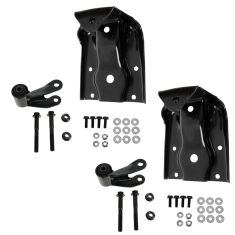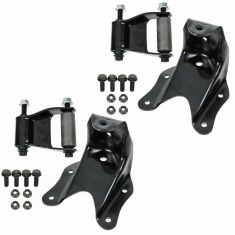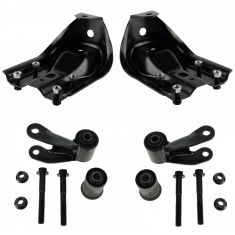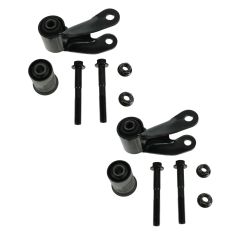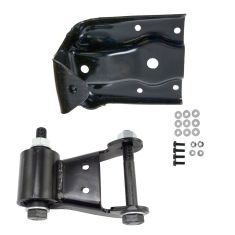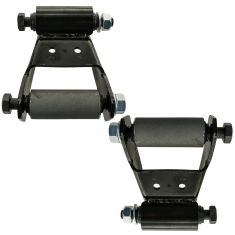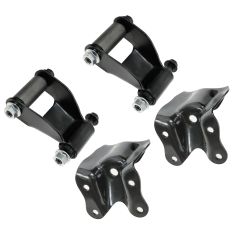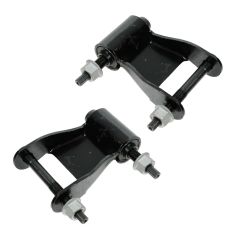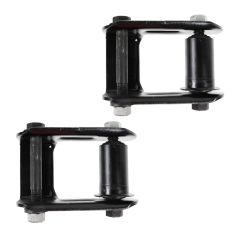Leaf Spring Shackles and Bracket Repair
-
-
- Air Deflectors & Valance Panels
- Battery Trays & Related
- Body Panels
- Bumpers & Related - Front & Rear
- Convertible Tops, Soft Tops, & Parts
- Decal & Stripe Kits
- Emblems & Nameplates
- Engine Compartment Trim
- Frame Parts & Bushings
- Fuel Door Parts
- Fuel Tank Filler Neck
- Grille
- Header Panel
- Hood & Hatch Lift Supports
- Hood Latch & Catch Brackets
- Hood Release Cable
- Jack Pads
- Radiator Supports
- Rust Repair Panels
- Splash Shields & Fender Liners
- Tailgate Cables
- Tailgate Hinges & Related
- Weatherstripping
-
- Car Covers
- Exterior Lighting
- Exterior Parts & Accessories
- Exterior Safety & Security
- Exterior Storage
- Fender Flares
- License Plate Brackets & Frames
- Mud Flaps & Splash Guards
- Nerf Bars, Side Steps, Running Boards
- Radio Antenna
- Rain Deflectors
- Roll Bars, Light Bars, & Related
- Roof Rack
- Skid Plates
- Spare Tire Carriers & Related
- Spare Tire Covers
- Tire Care
- Tonneau Covers
- Tow Hooks & D-Shackles
- Towing Accessories
- Trailer Hitch & Components
-
- Accelerator Pedal Pad
- Auto Carpet
- Brake Pedal Pad
- Clutch Pedal Pad
- Console Parts
- Dash Pad Cover
- Dash Vents
- Floor Mats & Liners
- Horns & Horn Parts
- Interior Parts & Accessories
- Mirror - Interior Rear View
- Seat Cover and Sets
- Seat Heater Kits
- Seat Parts and Accessories
- Sun Visors & Related
- Trunk & Cargo Parts
-
- Accelerator Pedals & Sensors
- Alarms, Control Modules, & Remote Start
- Cruise Control Switch & Lever
- Electrical Parts
- Hazard Switch
- Ignition Key Lock Cylinder
- Ignition Switch
- Keyless Entry Remote & Related
- Neutral Safety Switch
- Parking Assist Cameras & Monitors
- Power Mirror Switch
- Power Seat Switches
- Power Window Switch
- Radio, Navigation, Entertainment
- Reverse Light Switch
- Trunk Release & Lock Solenoids
- Turn Signal Switches and Levers
- Windshield Wiper Switch
-
- Idler Arm
- Pitman Arm
- Power Steering Hoses
- Power Steering Oil Cooler
- Power Steering Pressure Sensor
- Power Steering Pump
- Power Steering Pump Cooling Fan
- Power Steering Pump Pulley
- Power Steering Pump Reservoir
- Steering Dampers
- Steering Knuckles and Spindles
- Steering Rack and Gear Boxes
- Steering Shafts & Couplers
- Steering Wheels & Column Parts
- Tie Rods & Adjusting Sleeves
-
-
-
-
154
16
10
10
-
Notify When Available
Replaces Chevrolet GMC Rear Rearward 4 Piece Leaf Spring Shackle & Bracket Repair Kit TRQ PSA69178
Brand: TRQ - PSA69178$119.95Save 18%List $146.95 Save $27.00Brand: TRQ - PSA69178$119.95Save 18%List $146.95 Save $27.00 -
Notify When Available
Replaces Ford Bronco F150 F250 F350 Rear Driver & Passenger Side 2 Piece Leaf Spring Shackle & Bracket Repair Kit TRQ PSA66601
Brand: TRQ - PSA66601$104.95Save 29%List $147.95 Save $43.00Brand: TRQ - PSA66601$104.95Save 29%List $147.95 Save $43.00 -
Notify When Available
Replaces Chevrolet GMC Rear Rearward 4 Piece Leaf Spring Shackle & Bracket Repair Kit TRQ PSA71946
Brand: TRQ - PSA71946$99.95Save 28%List $138.95 Save $39.00Brand: TRQ - PSA71946$99.95Save 28%List $138.95 Save $39.00 -
Notify When Available
Replaces Chevrolet GMC Cadillac Rear Driver & Passenger Side Rearward 2 Piece Leaf Spring Shackle Repair Kit TRQ PSA66600
Brand: TRQ - PSA66600$49.95Save 29%List $69.95 Save $20.00Brand: TRQ - PSA66600$49.95Save 29%List $69.95 Save $20.00 -
Notify When Available
Replaces Chevrolet GMC Rear Rearward Leaf Spring Shackle & Bracket Repair Kit TRQ PSA69176
Brand: TRQ - PSA69176$69.95Save 26%List $94.95 Save $25.00Brand: TRQ - PSA69176$69.95Save 26%List $94.95 Save $25.00 -
Notify When Available
Replaces Ford Rear Driver & Passenger Side 2 Piece Leaf Spring Shackle Repair Kit TRQ PSA66609
Brand: TRQ - PSA66609$59.95Save 29%List $83.95 Save $24.00Brand: TRQ - PSA66609$59.95Save 29%List $83.95 Save $24.00 -
Notify When Available
Replaces Ford Mazda Rear Driver & Passenger Side 4 Piece Leaf Spring Shackle & Bracket Repair Kit TRQ PSA66604
Brand: TRQ - PSA66604$94.95Save 26%List $127.95 Save $33.00Brand: TRQ - PSA66604$94.95Save 26%List $127.95 Save $33.00 -
Notify When Available
Replaces Ford Lincoln Rearward 4 Piece Leaf Spring Shackle & Bracket Repair Kit TRQ PSA71574
Brand: TRQ - PSA71574$114.95Save 24%List $151.95 Save $37.00Brand: TRQ - PSA71574$114.95Save 24%List $151.95 Save $37.00 -
Notify When Available
Replaces 1994-02 Dodge Ram 2500 3500 Rear 2 Piece Leaf Spring Shackle Repair Kit TRQ PSA66614
Brand: TRQ - PSA66614$59.95Save 29%List $83.95 Save $24.00Brand: TRQ - PSA66614$59.95Save 29%List $83.95 Save $24.00 -
Notify When Available
Replaces Chevrolet GMC Olds Isuzu Rear Driver & Passenger Side Rearward Leaf Spring Shackle 2 Piece Set TRQ PSA66607
Brand: TRQ - PSA66607$54.95Save 27%List $74.95 Save $20.00Brand: TRQ - PSA66607$54.95Save 27%List $74.95 Save $20.00
loading...
Choose the Make of Your Vehicle
